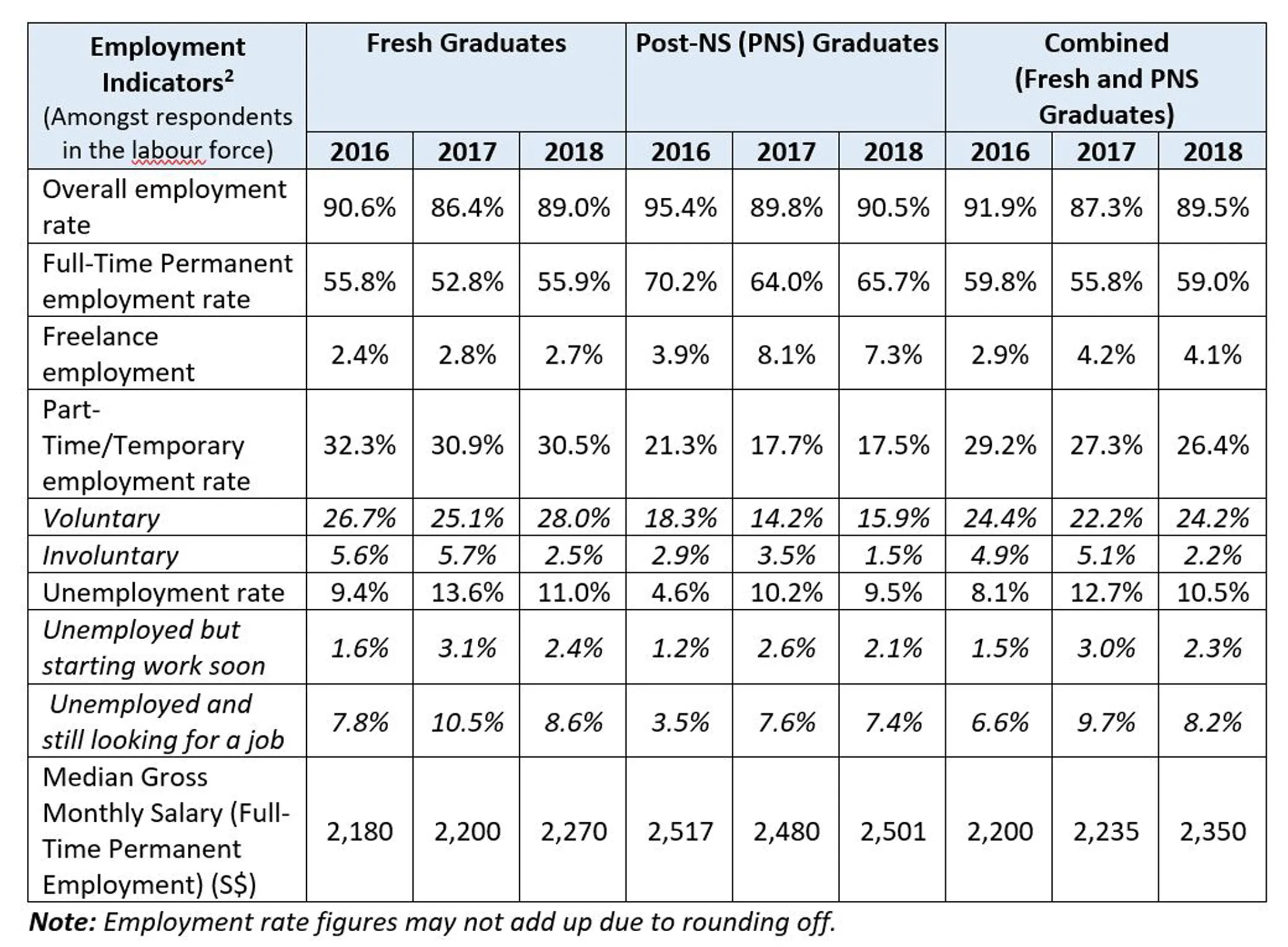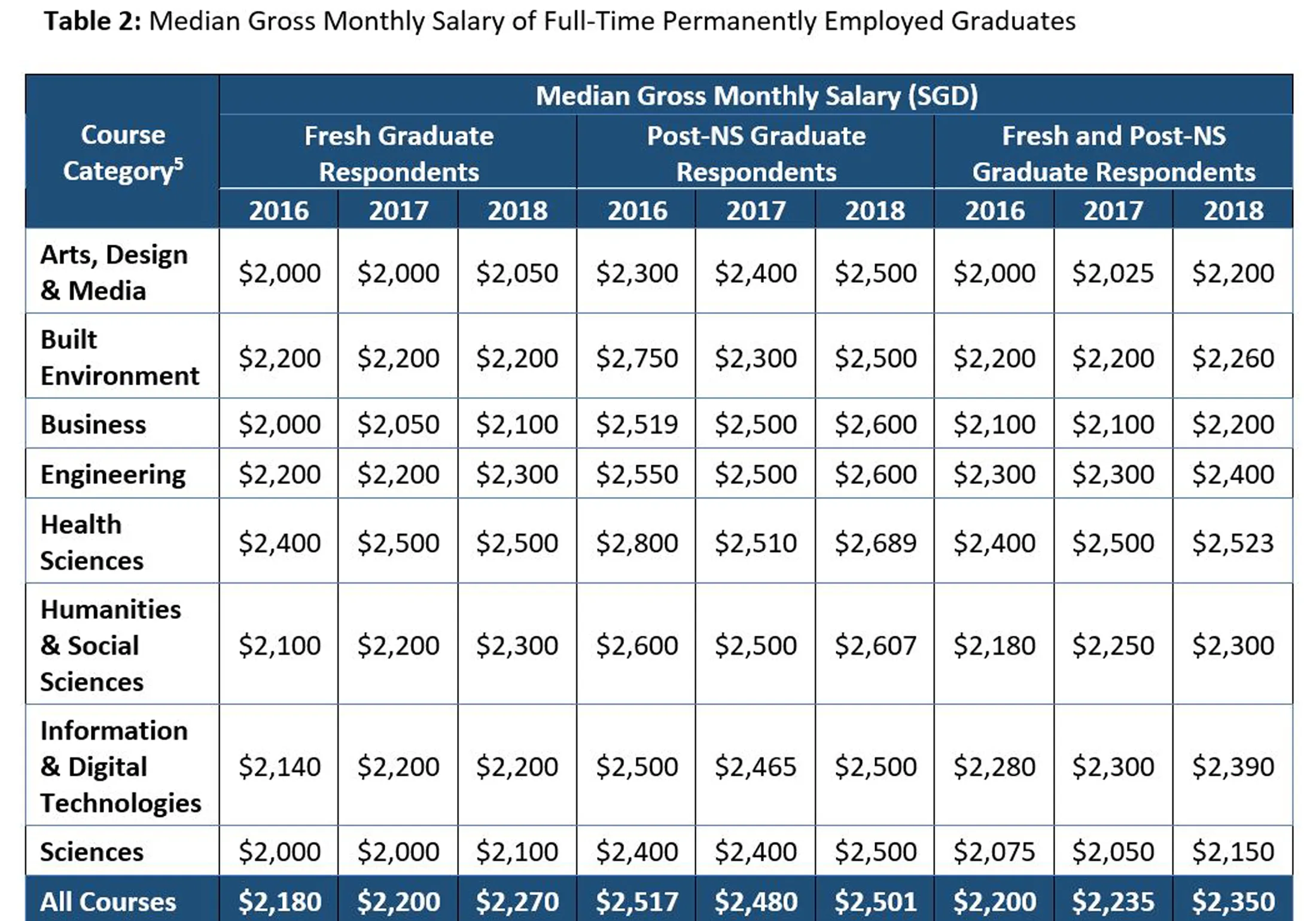Increase in Polytechnic Graduates Employed Within Six Months of Graduation in 2018
Post Date: 15 Jan 2019
Singapore, 15 January 2019 – The Graduate Employment Survey (GES), jointly conducted by the five polytechnics, showed that polytechnic graduates continue to be sought after by employers and commanded higher salaries in 2018 than in 2017.
Among respondents who entered the labour force, the overall employment rate six months after graduation was 89.5%, 2.2 percentage points higher than in 2017. The proportion who were unemployed and still looking for a job or in involuntary part-time/temporary employment decreased by 4.4 percentage points (see Table 1 below).
Table 1: Employment Rate (%)

[1] The overall employment rate refers to the number of graduates working in full-time permanent, part-time, temporary and freelance employment, as a proportion of graduates in the labour force (i.e. those who were working or not working but actively looking and available for work).
[2] Please see the list of definitions of the employment indicators in the Appendix.
For those in full-time permanent employment , the overall median gross monthly salary for all graduates increased from $2,235 in 2017 to $2,350 in 2018. Among the full-time permanently employed respondents, both fresh graduates and post-NS graduates from the Health Sciences category earned the highest median gross monthly salary. This is similar to that in 2017 (see Table 2 below).

[3] Full-time permanent employment refers to employment of at least 35 hours a week and where the employment is not temporary. It includes those on contracts of one year or more.
[4] Gross Monthly Salary comprises basic salary, fixed allowances, over-time pay, commissions, and other regular cash payments, before deduction of the employee’s CPF contributions and personal income tax. Employer’s CPF contributions, bonuses, stock options, other lump sum payments and payments-in-kind are excluded.
[5] Appendix II lists all diploma courses under each course category.
Fresh Graduates
9,330 out of 12,443 fresh graduates responded to the survey. As at 1 Oct 2018, around six months after the completion of their final examinations, 63.3% of respondents were in the labour force (i.e. those who were either working, or not working but actively looking and available for work). 36.0% were pursuing or preparing to begin further studies and hence not looking for jobs. Most of the remaining 0.7% said that they were taking a break and not seeking employment.
Of those in the labour force, 89.0% were employed in 2018 (see Table 1), up from 86.4% in 2017. 55.9% were in full-time permanent employment in 2018, up from 52.8% in 2017. 2.7% were working on a freelance basis , similar to the proportion in 2017. 30.5% were in part-time/temporary employment in 2018. The proportion doing so involuntarily (i.e. tried but were not successful in obtaining a full-time permanent job offer) was 2.5% of the labour force, down from 5.7% in 2017 . Most of the fresh graduates in part-time/temporary employment were pursuing or preparing to begin further studies. Of the remaining, most said that they were trying out the field/job to see if it was suitable for them, earning some income while searching for their ideal job, or preferred shorter and/or flexible work hours.
The median gross monthly salary among fresh graduates in full-time permanent employment was $2,270, up from $2,200 in 2017.
Post-National Service Graduates
5,657 out of 10,111 graduates from 2015 who completed their full-time NS between 1 Apr 2017 and 31 Mar 2018 also took part in the 2018 GES. 48.1% of respondents were in the labour force (i.e. those who were either working, or not working but actively looking and available for work). 51.5% were pursuing or preparing to begin further studies and hence not looking for jobs. Most of the remaining 0.4% said that they were taking a break and not seeking employment.
As at 1 Oct 2018, 90.5% of the respondents in the labour force were employed (see Table 1). Among those in the labour force, 65.7% were in full-time permanent employment, up from 64.0% in 2017. 7.3% were working on a freelance basis, down from 8.1% in 2017. 17.5% were in part-time/temporary employment in 2018. The proportion doing so involuntarily (i.e. tried but were not successful in obtaining a full-time permanent job offer) was 1.5% of the labour force, down from 3.5% in 2017. Similar to fresh graduates, most of the post-NS graduates in part-time/temporary employment were pursuing or preparing to begin further studies. Of the remaining, most said that they were trying out the field/job to see if it was suitable for them, earning some income while searching for their ideal job, or preferred shorter and/or flexible work hours.
[6] Freelance Employment refers to those who operate their own business without employing any paid worker in the conduct of their business or trade.
[7] Part-time Employment refers to employment of less than 35 hours a week. Temporary Employment refers to casual, interim or seasonal employment, including those on contracts of less than one year.
[8] In the 2018 Polytechnic GES, the option on involuntary part-time/temporary employment was changed from ‘Tried to but unable to find Full-Time Permanent job so far’ to ‘Tried to but unable to obtain a Full-Time Permanent job offer so far’
The median gross monthly salary of respondents who were post-NS graduates in full-time permanent employment was $2,501, up from $2,480 in 2017.
Longer-Term Trends
Sharing the Committee’s observations on longer-term trends, the 2018 GES Committee spokesman said, “Over the years, we observed that students are becoming more open to voluntary part-time/temporary and freelance employment, besides full-time permanent employment. This is a reflection of rising desire to further their studies, and also evolving employment preferences among our polytechnic graduates. Based on past trends, the majority of those initially in part-time/temporary employment transited to full-time permanent jobs after some time. Data also shows that our graduates enjoy good wage growth even as overall employment rates remain high.”


